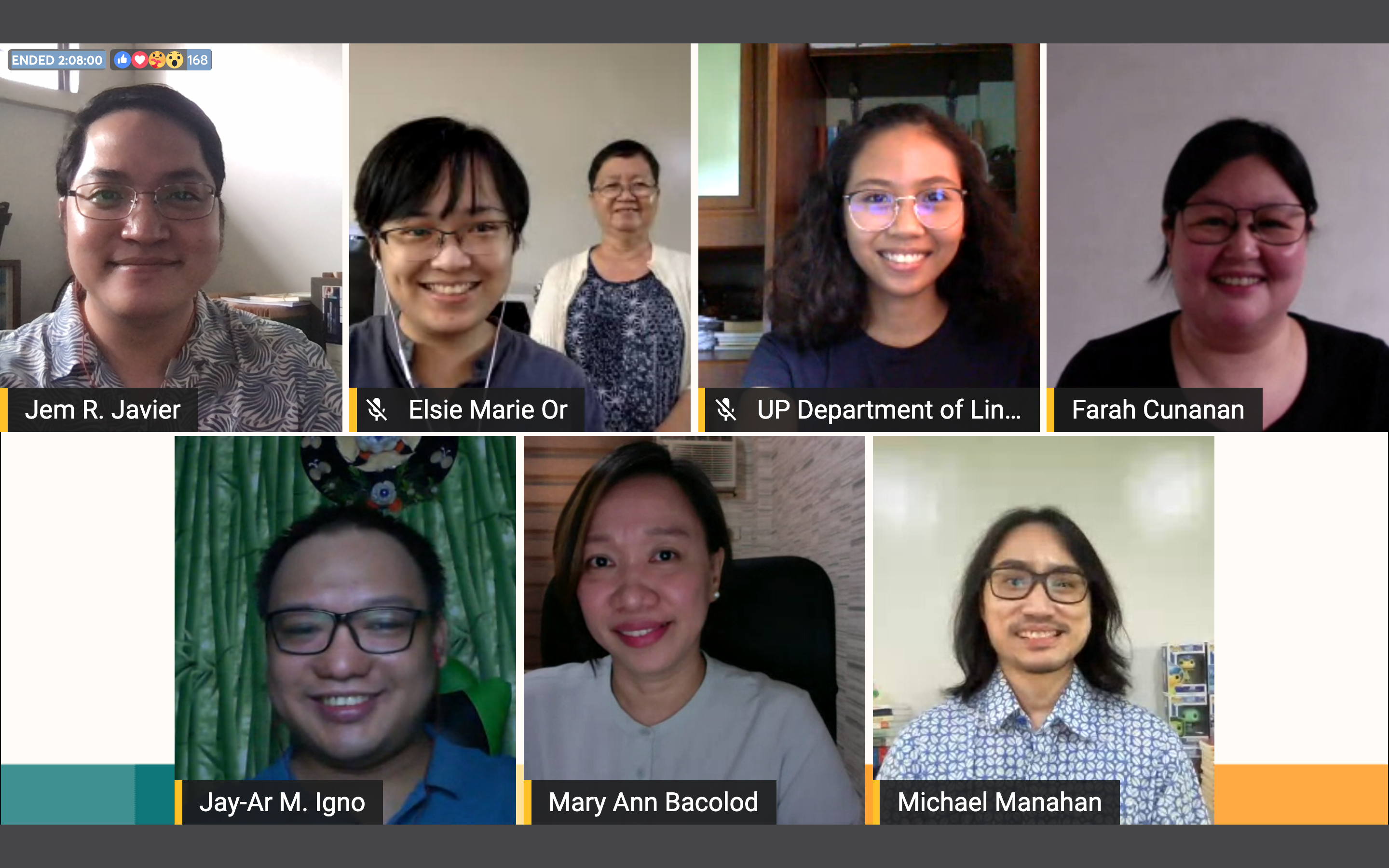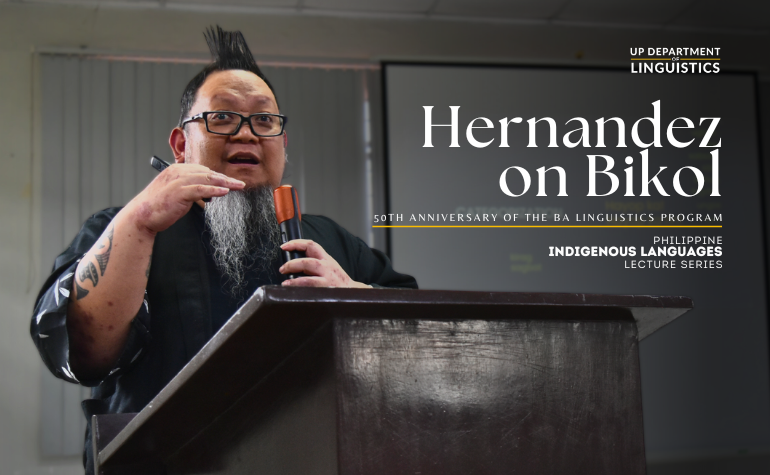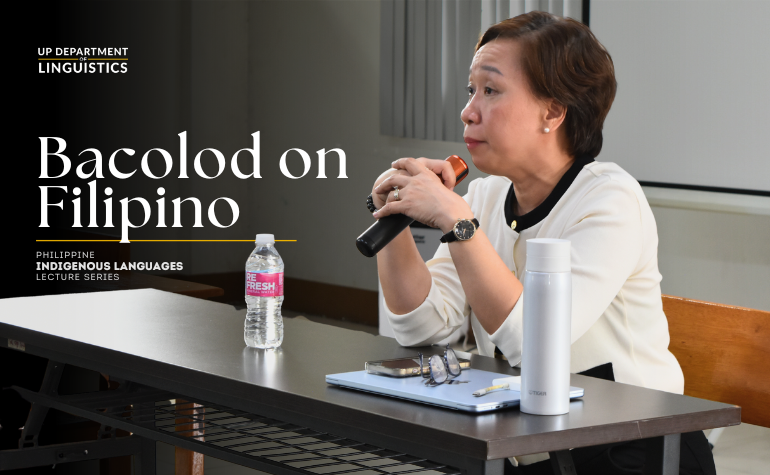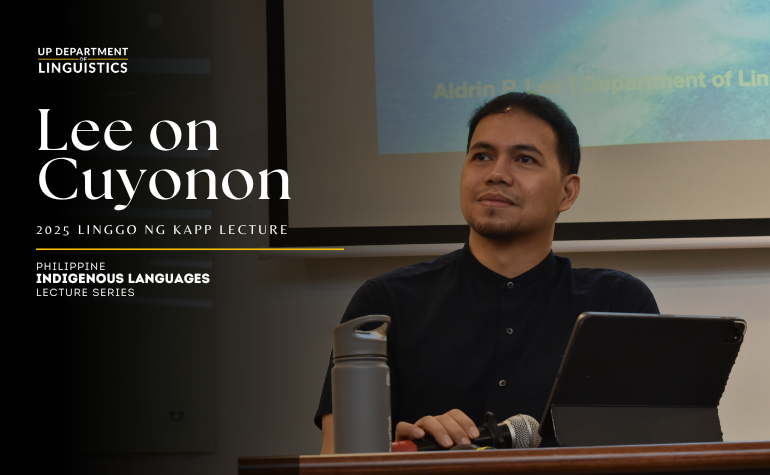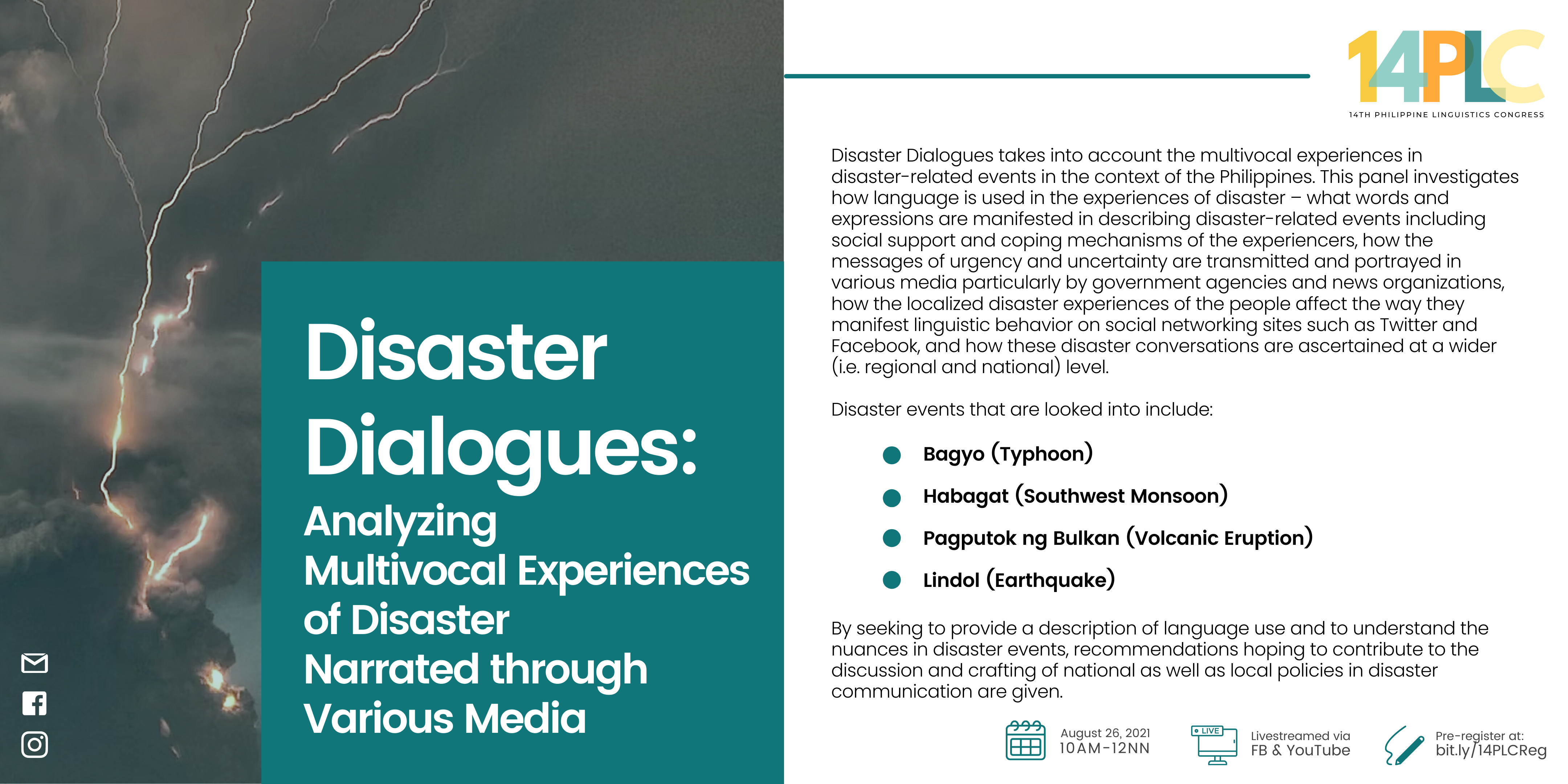
The UP Department of Linguistics, in celebration of its 99th founding anniversary, hosted the 14th Philippine Linguistics Congress (14PLC). This four-day event consisted of five-panel presentations which started from August 24 to August 27.
The final-day session, “Disaster Dialogues”, introduced the multivocal experiences in disaster related events in the context of the Philippines. The disaster events that are investigated involve lindol (earthquake), pagputok ng bulkan (volcanic eruption), bagyo (typhoon), and habagat (southwest monsoon). The final panel included Assoc. Prof. Mary Ann G. Bacolod, Ph.D., Asst. Prof. Jem R. Javier, Inst. Michael S. Manahan, Asst. Prof. Ria P. Rafael, Asst. Prof. Farah C. Cunanan, and Asst. Prof. Jay-Ar M. Igno. This event was moderated by Inst. Michael S. Mahanan.
Understanding Earthquake Risk Perception
The first discussion was delivered by Dr. Bacolod. The research aims to examine: (1) the perceptions, (2) the effects and risks, (3) the cultural, social, and emotional functions; and (4) the status of the present-day disaster risk communication, all in terms of lindol. The data were gathered from online newspapers, advisories, information, public comments, and earthquake-related posts from 2020 to 2021. With the analysis, Dr. Bacolod concluded that Filipinos consider lindol as an animate object that causes disruption (e.g., ginising), a destructive experience (e.g., napa-, nakaka– affixes), and an unexpected or uncertain event (e.g., ginulat).
Moreover, PHILVOCS DOST or any news provider highlights the intensity of lindol not on a numeral description basis but on its actual effect(s) which is experienced by the people, or the current state of a location and activity affected by the disaster. The intensity is commonly described with the use of intensive or superlative forms of adjectives (e.g., lakas, hina) instead of the PHILVOCS Earthquake Intensity Scale (PEIS). In addition, an emphasis was observed in implying the earthquake’s duration, with the use of adverbs of frequency (e.g., ilang beses, minuto o segundo), and its distance with the use of spatial expressions (e.g., abot sa, hanggang sa).
Based on the narratives, religion is also given importance during the disaster period—public comments or earthquake-related posts present the use of metaphors in terms of religious beliefs and various descriptions of the earthquake as the cause of immoral activities or God’s fuming. From a perspective, Dr. Bacolod insisted that there is a privation of proper knowledge that revolves around the characteristics and causes of lindol, and on the preparedness during an earthquake scenario. Consequently, according to her data, the intensity descriptions of lindol are more roundabout than the safety steps that are needed during the said disaster.
Dr. Bacolod ended her discussion by giving several recommendations: (1) proceed with clear, simple, common, and consistent language use; (2) affirm relatable earthquake scenarios; (3) provide ‘locally specific information’; (4) disseminate sufficient information in terms of disaster preparedness; and (5) reflect from the drawbacks to be able to establish disaster-ready information and refine disaster risk communication.
Naburog nga? A multivocal narrative of the Taal volcano eruption experience
The second discussant was Asst. Prof. Jem R. Javier. The presentation intends to: (1) gain insights on how social media such as Facebook has accommodated the experiences of the ‘participants’ of an extreme environmental disaster; (2) offer a framework in navigating the different and multivocal narratives related to volcanic eruption; and (3) thresh out the narratives in order to describe the experiential and collective memories of the community that is most affected by the volcanic eruption. The Taal narratives were extracted from PHILVOCS-DOST’s official Facebook posts alongside the respective netizen engagements for July 2021.
From the data, different innovative ways of shaping the language were observed in describing the experiences, perceptions, and viewpoints with regards to the pagputok ng bulkan—to which figures of speech such as hyperbole, personification, and metaphor were evident in describing the Taal eruption. Aside from the figures of speech, he expressed that some localized lexical items undergo semantic change in relation to the volcanic eruption event. Hence, there are local terminologies that are being used to directly classify several concepts such as burog for volcanic earthquake, pabusngi-busngi for phreatic explosion, and pag-iga for the water diminution inside the volcanic crater. He explained that the prevalent usage of social media comes with diverse user interactions or dialogues. Based on the Taal context, the data showed different user dialogues such as experiencer to institution, experiencer to experiencer, experiencer to observer, experiencer to higher being, and experiencer to self.
He said that “ang pinagkakatiwalang bukal ng kaalaman ay kolektibong kasaysayan na nagmula sa mga nakakatanda na siyang nakaranas ng huling pagputok ng bulkan gaya ng konsepto ng ‘burog’ at kaugnayan nito sa mga nakakatanda sa komunidad…, bago ang panahon ng social media, mga institusyon tulad ng PHILVOCS-DOST, ang kaalaman sa paligid ay nagmumula sa gunita at kaalaman ng mga nakaranas nito sa nakaraan.”
In the final part of his discussion, he emphasized several realizations based on his research—the language and linguistic repertoire are used: (1) to utilize communication and to achieve a certain expected behavioral outcome; (2) as a repository of collective experiences of the individual and group; and (3) as a vehicle through which culture is transferred to new members of the community. In addition, since people participate in multiple interactions (dialogues) especially during an important or extreme event, he recommended an ‘interdisciplinary approach’ in navigating, explaining, and responding to disasters to come up with informed, appropriate, democratized, and empowering responses and decisions.
Bagyo
The third discussion was presented by Inst. Michael S. Manahan. The research was conducted with Asst. Prof. Ria P. Rafael and Asst. Prof. Farah C. Cunanan. Its main objective is to analyze textual data in social media conversations (of experiencers and observers) related to bagyo in order to detect Filipino sentiments and emotions from conversations revolving around this event. The data source came from Twitter with a timespan of November 2020 to May 2021. Specific themes were extracted from the analysis of the corpus, such as civic participation, remote setup, and sentiments (or experiences) of Twitter users during the disaster period.
Rafael’s research delved into the direct interaction of the experiencer and the event itself. First, she analyzed dictionaries and came up with typhoon-related expressions such as sama ng panahon, unos, and sigwa. She also looked into PAGASA-DOST weather bulletin reports, in which severe weather bulletin, extended weather outlook, and area of responsibility are some of the extracted recurring expressions. Common information such as warnings before the occurrence of a typhoon, movements of the typhoon, weather reports, and effects of the typhoon are also posted by PAGASA on their weather bulletin. She also included an analysis of a Tagalog corpus (compiled from 2018 to 2019) from Sketch Engine to show a visualization of the frequency and collocations of the entries related to bagyo. With the corpus, she grouped the entries to identify the specified categories of the lexemes, which are movement, position, character, time, and effect.
Cunanan ended the discussion on bagyo with some recommendations on effective disaster communication in terms of this weather phenomenon. The first recommendation refers to inclusivity: (1) easy to understand language and vocabulary; and (2) social, economic, cultural, historical, emotional factors, and special needs. The second recommendation indicates clear messaging: (1) relatable and connects with the audience; and (2) clear and consistent call to action; operationalization. Lastly, the third recommendation implies dissemination: (1) widest reach possible and various accessible means; and (2) regular, up-to-date, accurate, consistent information and response.
Habagat
The fourth discussion was delivered by Asst. Prof. Jay-Ar M. Igno. The study intends to: (1) assess communication messages (online) of government agencies through different media platforms on southwest monsoon a.k.a habagat preparedness and audience’s response and understanding on its effects to the community; and (2) apply the communication principles presented in Haddow and Haddow (2009) in relation to four phases of Emergency Management: mitigation, preparedness programs and actions, response, and recovery. The data were collected from PAGASA-DOST weather reports, NDRRMC, PIA, and Science Watch Philippines which are delivered through various media such as online websites, short messaging service, YouTube, and Facebook.
During the session, he presented different types and examples of vocabulary usages elicited from the data based on the four phases of Emergency Management. For mitigation and preparedness combined: (1) the use of noun phrases, verb phrases, and adjectival phrases pertaining to warning (e.g., pag-iingat, pagmamatyag, maapektuhan); (2) the use of acronym (e.g., DOST-PAGASA, LPA, MiMaRoPa); and (3) the use of not so familiar terms (e.g., manaka-naka). For response: (1) the use of verb phrases pertaining to continuous action or experience (e.g., nararanasan(g), magtuloy-tuloy, makakaranas); (2) the use of adjectival phrases pertaining to description of the phenomenon (e.g., mahina, malakas, kalat-kalat); and (3) the use of verb phrases pertaining to precautions (e.g., asahan, mag-ingat, maghanda). Lastly, for recovery: (1) the use of verb phrases pertaining to the effects of the phenomenon (e.g., isinailalim, idineklara, nagreresulta); (2) the use of adjectival phrases pertaining to the state of effects (e.g., state of calamity, malakas, gradual); and (3) the use of noun phrases pertaining to the things affected (e.g., agrikultura, kalsada, pananim).
He also shared salient observations and remarks based on the data. As stated, there are efforts by media organizations to make the content more understandable by delivering most of the news reports in Filipino with some English terms for some technical concepts. However, there are also some words or phrases that need further explanation. Lastly, he emphasized that some comments are showing the ‘confusion’ of people with the term habagat by associating it more often with typhoons or tropical depression.
Open Forum
At the end of the panelists’ discussions, an open forum allowed the participants to post their questions related to the event’s topics.
One is about the introduction of the subject Purposive Communication into the GenEd curriculum with the purpose of addressing the pertinent government agencies’ inability to communicate properly to the public in times of tragedies and calamities (Yolanda lessons). The question is about the effectiveness of the subject in addressing the problem and how is it integrated in the lessons.
Bacolod and Cunanan clarified that the UP Department of Linguistics has no direct connection to this GenEd subject. However, they suggested that teachers can integrate lessons or activities related to disaster-risk awareness—to which the students will learn various disaster-related terms and reciprocate to different disaster-related issues correspondingly.
Another question asked if there were terminologies about disasters collected in other languages that have no equivalent in the major languages or those with more speakers. It is followed up by inquiring on its possible implications to the experiences of the speakers.
Bacolod, Javier, and Cunanan stressed that the linguistic data elicited from the online platforms generally focus on the Filipino language. On the other hand, the implication centers on the speakers’ perceptions of the risk factors and effects of disasters based on their varying experiences. “It would also be a great opportunity to start gathering linguistic data from other ethnolinguistic groups, in which localization and contextualization go hand in hand,” Javier and Cunanan added.
Another inquiry is on the glaring difference in the encoding of risk between the pandemic and disasters: about the pandemic, euphemistic or mitigative language is used (‘enhanced’, ‘modified’ quarantine instead of lockdowns or alert levels), whereas for disasters, urgency is encoded (in alert levels, code red, code orange). The pandemic is a disaster too, and the risks should be regarded similar to how risks are regarded during disasters.
Bacolod and Cunanan implied that the current COVID-19 pandemic is considered a biological disaster. Furthermore, the perception(s) towards a pandemic versus a geophysical or meteorological disaster mainly depends on the people, where an established communication based on localized specific information is deemed important.
Results from the studies on this panel will be included in the creation of a dictionary on disaster-related terms in various Philippine languages. The recording of the panel presentations can be viewed on our YouTube channel.
Published by Orlyn Joyce D. Esquivel

